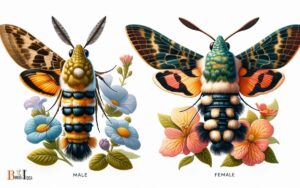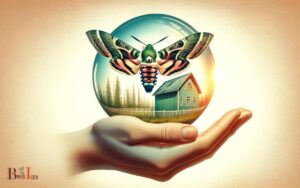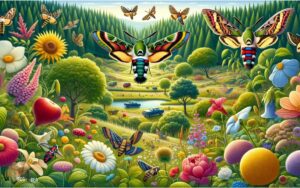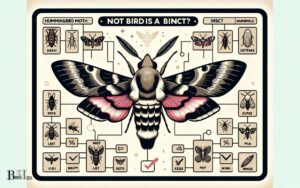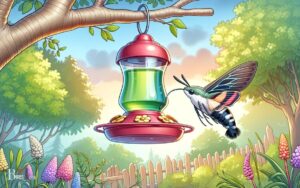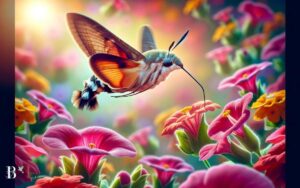What Caterpillar Turns Into a Hummingbird Moth? Sphinx Moth!
The caterpillar that turns into a Hummingbird Moth is known as the Sphinx Moth or Hornworm.
This caterpillar undergoes metamorphosis, transforming into a pupa before emerging as an adult moth.
The specific species commonly associated with this transformation is the Hummingbird Hawk-Moth (Macroglossum stellatarum).
The caterpillar is characterized by its green color, resembling a small horn and having a distinctive pattern.
As it progresses through its life cycle, it forms a pupa, which later gives rise to the adult Hummingbird Moth.
The adult moth exhibits behavior similar to that of a hummingbird, hovering in front of flowers and feeding on nectar with a long proboscis.
This remarkable transformation showcases the diversity and adaptability within the insect world.
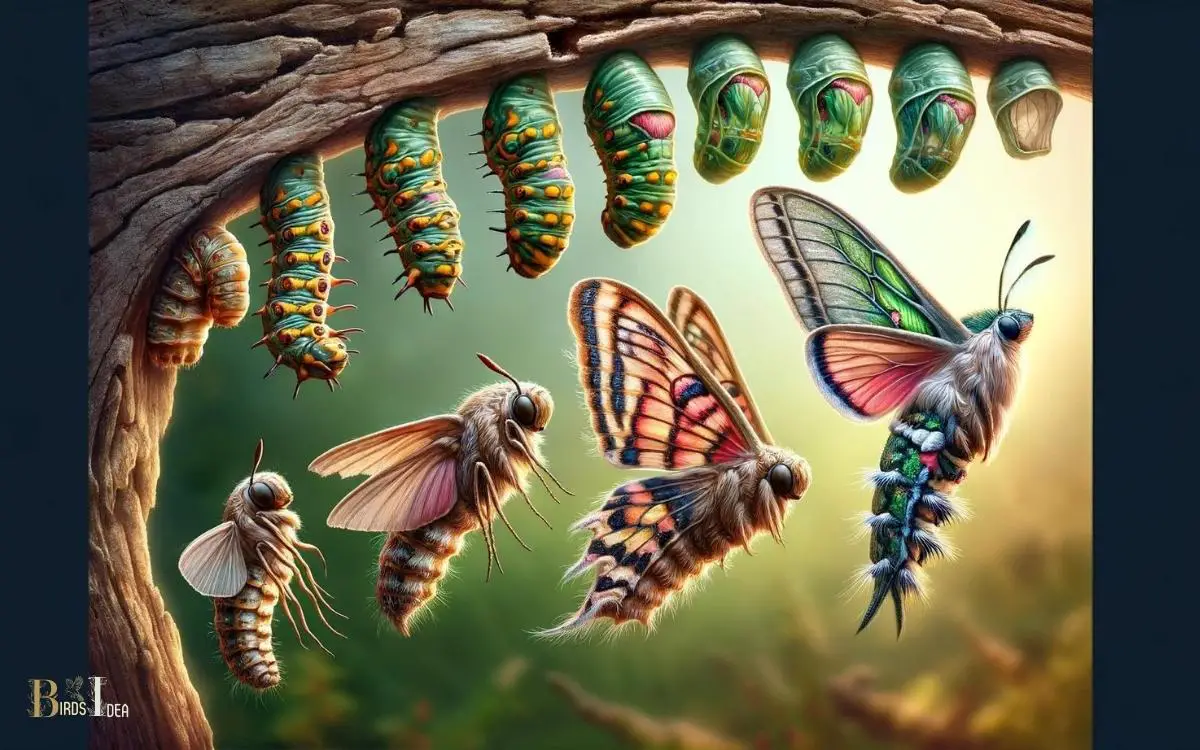
Key Takeaway
Caterpillar Identification
The caterpillar of the hummingbird moth can be identified by its distinctive green color and diagonal white stripes. It has a plump body with several segments, each adorned with these vibrant markings.
The caterpillar’s head is pale green with a pair of short black horns. Its skin is slightly rough, providing protection from predators.
The caterpillar moves with a distinct undulating motion, propelled by its tiny legs. When at rest, it often curls into a tight spiral, camouflaging itself among the leaves.
As it grows, the caterpillar molts several times, shedding its old exoskeleton to accommodate its increasing size.
The mature caterpillar reaches a length of about 2 inches before it pupates, beginning its transformation into the extraordinary hummingbird moth.
Life Cycle of a Hummingbird Moth
The life cycle of a hummingbird moth begins with the larvae’s feeding habits, which play a crucial role in their development.
The pupal transformation process is a fascinating stage, as the larvae undergo metamorphosis into adult moths.
Once the adult moths emerge, their behavior and interactions with their environment unveil more about their life cycle.
Larvae Feeding Habits
During their larval stage, hummingbird moth caterpillars primarily feed on the leaves of their host plants.
These caterpillars, known scientifically as sphingidae larvae, are voracious eaters. They consume the foliage of various plants such as honeysuckle, hawthorn, and snowberry.
Their feeding habits contribute to their rapid growth, enabling them to undergo multiple molts as they progress through their larval stage.
The caterpillars use their strong mandibles to chew and consume large quantities of leaves, allowing them to store energy for their subsequent transformation into pupae. This stage of their life cycle is crucial for their development into adult hummingbird moths.
Understanding the feeding habits of hummingbird moth caterpillars provides insights into their ecological role and aids in conservation efforts for their host plants.
Pupal Transformation Process
Hummingbird moth caterpillars undergo a remarkable pupal transformation process as they progress through their life cycle.
- Pupal Stage: After the caterpillar reaches full growth, it forms a pupa, also known as a chrysalis, where it undergoes metamorphosis.
- Metamorphosis: Inside the pupa, the caterpillar’s body undergoes a complete transformation, breaking down and reorganizing its tissues to emerge as a hummingbird moth.
- Emergence: Once the transformation is complete, the adult hummingbird moth emerges from the pupa, ready to begin its short but active adult life stage.
During this pupal transformation process, the caterpillar’s body undergoes a series of intricate changes, preparing it for its life as a hummingbird moth.
This remarkable process is a crucial part of the hummingbird moth’s life cycle, enabling it to transition from a crawling caterpillar to a graceful, nectar-feeding moth.
Adult Moth Behavior
The hummingbird moth’s adult moth behavior reflects its remarkable life cycle as it navigates the challenges of seeking nectar and finding suitable mating partners.
As adults, hummingbird moths are primarily nocturnal, using their keen sense of smell to locate flowers with abundant nectar.
They’re often seen hovering in front of blossoms, using their long proboscis to reach deep into the flower to extract nectar while in flight, much like their avian namesake.
Mating behaviors involve the release of pheromones by the female to attract males. Once mated, the female deposits her eggs on suitable host plants, usually those favored by the caterpillars for feeding and development.
After this crucial stage, the life cycle begins anew, with the eggs hatching into caterpillars, perpetuating the cycle of the hummingbird moth’s fascinating life.
Caterpillar Feeding Habits
The caterpillar of the hummingbird moth feeds on a variety of plants and foliage to sustain its growth and development.
Preferred Host Plants:
The caterpillar typically feeds on plants such as honeysuckle, hawthorn, snowberry, and dogbane.
These plants provide the necessary nutrients for the caterpillar’s development into a mature moth.
Feeding Behavior:
The caterpillar is known for its voracious appetite, consuming large quantities of leaves and other plant parts.
It feeds primarily during the night and early morning, often retreating to rest during the heat of the day.
Adaptations for Feeding:
The caterpillar has specialized mouthparts adapted for chewing and consuming plant material.
It uses its strong mandibles to efficiently process and ingest the leaves and foliage essential for its growth.
Understanding the caterpillar’s feeding habits provides insight into its dietary requirements and ecological role in its natural habitat.
Pupa Formation and Metamorphosis
Pupa formation occurs as the caterpillar undergoes metamorphosis into a hummingbird moth.
During this phase, the caterpillar attaches itself to a substrate using silk and undergoes a remarkable transformation.
Its body undergoes significant changes, including the development of wings, legs, and other adult structures.
Inside the pupa, the caterpillar’s tissues break down and reorganize into the body of a hummingbird moth.
This process involves the activation of specific genes that regulate the transformation of cells and tissues.
The pupal stage is a critical period where the caterpillar’s body is reorganized into a completely different form, enabling it to emerge as a fully developed and capable hummingbird moth.
Understanding this process provides insight into the intricate and fascinating world of insect metamorphosis.
Characteristics of the Hummingbird Moth
With six legs and a streamlined body, the hummingbird moth resembles its avian namesake as it hovers and feeds on nectar from flowers.
This remarkable insect possesses several distinctive characteristics:
- Clear Wings: The wings of the hummingbird moth are transparent, allowing for effortless and swift flight, much like its namesake, the hummingbird.
- Long Proboscis: The moth’s long, tubular mouthpart, known as a proboscis, enables it to reach deep into flowers to access nectar, mirroring the feeding behavior of hummingbirds.
- Rapid Flight: The hummingbird moth is capable of agile and rapid flight, often hovering in front of flowers while feeding, displaying a remarkable similarity to the flight patterns of hummingbirds.
These unique characteristics contribute to the moth’s fascinating resemblance to the hummingbird, making it an intriguing insect to observe in the natural world.
Habitat and Range
The hummingbird moth can be found in a variety of habitats, including gardens, meadows, and fields. Its geographic distribution spans across North America, Europe, and parts of Asia.
Understanding the specific habitats and ranges of these moths is crucial for conservation efforts and understanding their ecological role.
Hummingbird Moth Habitats
An adult hummingbird moth can be found in various habitats across North and South America.
These moths are adaptable and can thrive in diverse environments, displaying a wide habitat range.
- Gardens and Flower Fields: Hummingbird moths are commonly spotted in gardens and flower fields, where they feed on nectar from a variety of flowering plants.
- Woodlands and Forest Edges: These moths are also prevalent in woodlands and forest edges, where they can find suitable nectar sources and lay their eggs on host plants such as honeysuckle and hawthorn.
- Grasslands and Meadows: In grasslands and meadows, hummingbird moths are frequently seen hovering around and feeding on wildflowers, utilizing the open spaces for foraging and mating.
Geographic Distribution of Moths
Hummingbird moths inhabit a wide geographic range across North and South America, adapting to various habitats for foraging and reproduction.
These moths are commonly found in meadows, gardens, and forest edges where their preferred nectar sources like honeysuckle, bee balm, and phlox grow abundantly.
Their geographic distribution spans from as far north as Canada to as far south as Argentina, with different species occupying specific regions within this range.
For example, the hummingbird clearwing moth (Hemaris thysbe) is prevalent in the eastern United States and Canada, while the white-lined sphinx moth (Hyles lineata) is commonly sighted in the southwestern United States.
This diverse distribution allows hummingbird moths to thrive in a variety of climates and ecosystems, making them a fascinating subject for ecological study.
What are the differences between a Hummingbird Moth and a Sphinx Moth?
The key differences between hummingbird moth vs sphinx moth lie in their appearance and behavior. Hummingbird moths have clear wings and are active during the day, while sphinx moths have thicker, opaque wings and are active at night. Additionally, the two species have distinct feeding preferences and habitat choices.
Interactions With Humans
Many people are fascinated by the interactions between the caterpillar of the hummingbird moth and humans.
These interactions are intriguing due to the unique behaviors and appearances of the caterpillar.
Observations have shown that the caterpillar of the hummingbird moth often captures the attention of humans, leading to various interactions.
- Educational Outreach: Many educational programs and exhibits feature the hummingbird moth caterpillar to teach people about the natural world and the intricate life cycles of insects.
- Gardening Communities: In gardening communities, individuals may encounter these caterpillars while tending to their plants, sparking an interest in learning more about these creatures and their role in the ecosystem.
- Photography and Art: The distinctive appearance and behavior of the caterpillar often inspire photographers and artists to capture its beauty and uniqueness in various forms of media.
Conclusion
The life cycle of the hummingbird moth is a fascinating and intricate process. Did you know that a hummingbird moth can beat its wings at a rate of 70 to 90 times per second, similar to a hummingbird?
This astonishing fact showcases the remarkable capabilities of these unique creatures and highlights the importance of understanding and appreciating the natural world around us.

